How To Draw A Nose Properlyu
The Basics of the Nose
For some reason, when it comes to noses, people struggle. Perhaps this is because a nose is an irregular class - it's not a simple shape like a circle and it's non quite a triangle either. It's not as hard to depict realistic noses as one may think. It'southward actually rather simple. All it takes is four lines and then the residual is calculation value. Don't fall into the trap of thinking that drawing noses is difficult.
Many people have incorrectly learned how to draw a olfactory organ. When you learn something incorrectly, it is even harder to learn how to practice it correctly. This is true of anything, not just cartoon. Many of us have been taught to depict that "L" shape or possibly the "w" shape with an extra "u" when we draw a nose.

Cartoon noses this style is and so far from drawing them realistically. If you are going for a cartoon nose, so that may be a good direction to become. But for a realistic nose, y'all must really find your subject.
Here's a look at the finished cartoon from the video above...

The Primal is Ascertainment
Y'all must closely observe your field of study when you draw anything. Drawing noses realistically involves studying the values. The values are what gives u.s. the impression and illusion of the course. Brand sure that you include a full range of value when you draw a nose.
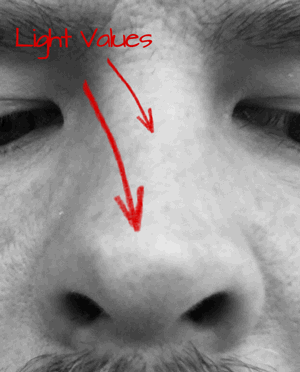 Drawing lines will help to establish the shape of the olfactory organ, only it's the values that will atomic number 82 to the illusion of form that you probably want in you drawing.
Drawing lines will help to establish the shape of the olfactory organ, only it's the values that will atomic number 82 to the illusion of form that you probably want in you drawing.
Your drawing must include the darkest shades and the lightest tints and the grays in between. Proceed in mind that no two noses will be the same. Observation is really the biggest secret when it comes to drawing.
Attempt to pinpoint the locations on the nose where these values are located and notice the subtle changes that happen in the highlights (light values), midtones (eye values), and the shadows (dark values).
Drawing a Nose from a Frontal View
We'll explore several dissimilar options for drawing a olfactory organ in this lesson and expect at a number of examples. It makes sense to look at drawing the nose from a frontal view first. This way, nosotros can better empathise the structure and what we should expect for and include in our drawing.
Before drawing whatever lines, nosotros'll first examine the form of the nose and how we tin simplify information technology into a system of planes.
Agreement the Planes of the Nose
A nose tin can be simplified into basic planes. You may recall of a chiseled class to better understand the planes. Remove the curvature of the olfactory organ from your mind and simplify the form into rigid flat planes.
Recognizing the planes not but helps u.s. to describe the grade, but it likewise helps us to sympathize where nosotros should add shading. It is the shading, or value range, that ultimately leads to the illusion of a 3-Dimensional form.
In the image below, you'll see an instance of a olfactory organ from a frontal view, simplified into basic planes. As the form changes direction in space, information technology creates a new plane. In that location are three planes designated for the top, iii for the centre, and iii underneath.
In the first stages of the drawing, you lot may find information technology helpful to draw these planes first. This manner, you can focus on the form before cartoon any of the lines for the nostrils or adding tone.
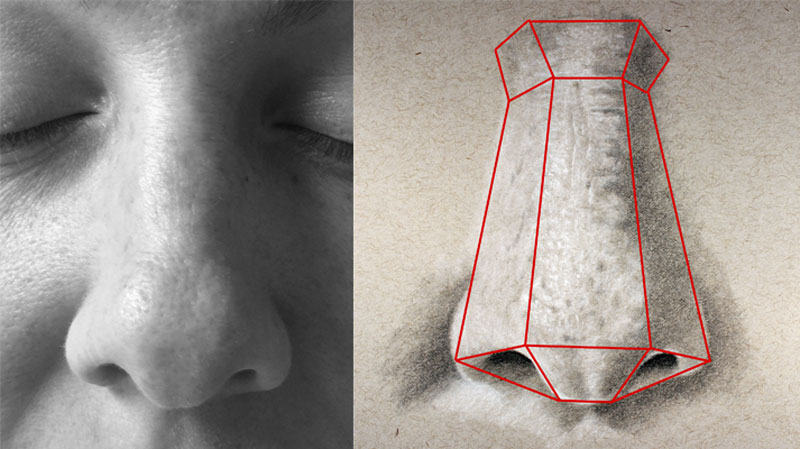
Drawing the Perceived Lines
When about of u.s.a. learn to draw, we start by drawing lines. Nosotros use lines to define the boundaries of objects and to add details. So it's only natural to look for lines when we depict any object.
A nose, however, doesn't feature strongly defined lines. Our heed simplifies changes in value or dissimilarity into "perceived lines". For a nose, these areas include the shapes of the nostrils and the outer edges of the nostrils. This is only because we notice stiff contrast in value in these locations. In reality, the value changes gradually, instead of creating a defined line.
We can utilize the planes of the nose to position the perceived lines that we come across. Using the outer boundaries of the planes, we can marking the outer edges of the nostrils. Nosotros tin also use the bottom planes to position the shapes of the nostrils.
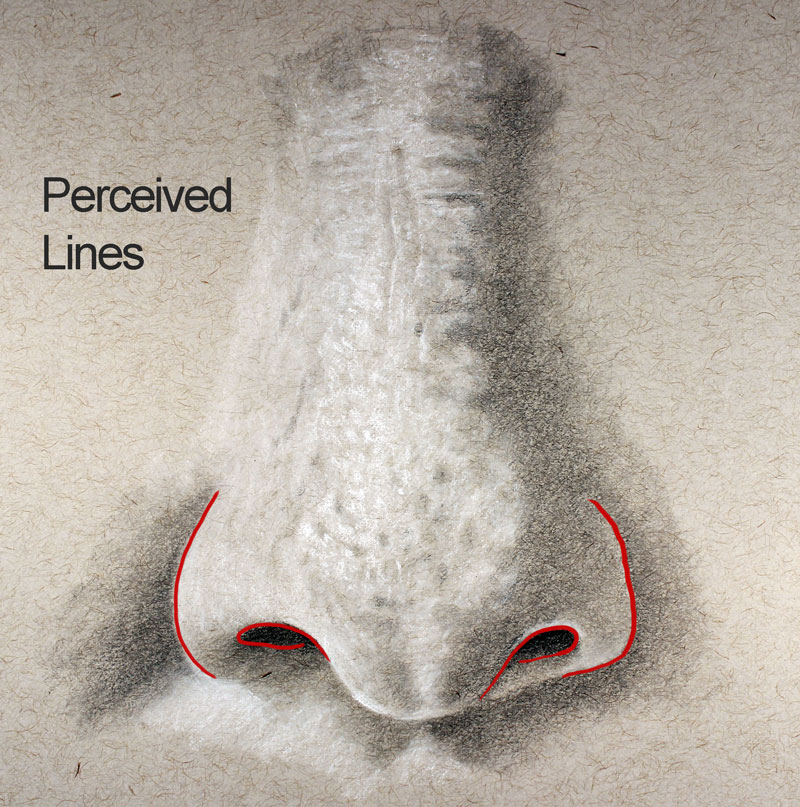
Shading the Nose
Understanding the planes of the nose helps the states to draw the basic construction and position the "perceived lines", merely the planes also perform some other important task. We can use these planes to determine the locations of value.
In this example, the light source originates from the upper left corner. This produces lighter values on the left side of the nose, closer to the lite source. This means that the plane that faces the light source will be lighter. Darker values are plant on the contrary aeroplane on the right side of the olfactory organ.
Since our light source is also coming from higher up, you'll notice that the planes underneath the olfactory organ are also darker. There is, notwithstanding, a slight highlight in areas here.
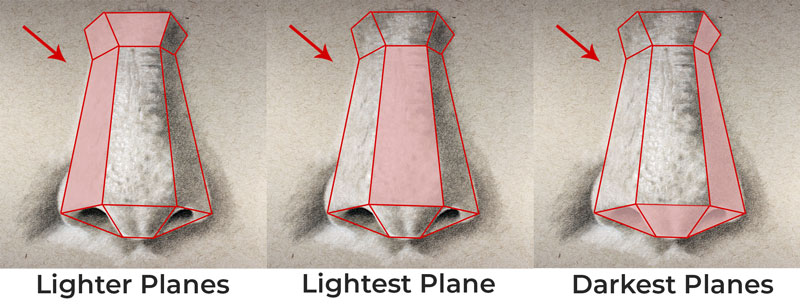
The span of the olfactory organ protrudes outward. As a general rule, nigh objects that protrude receive more lite and are usually lighter in tone. They also unremarkably produce a shadow underneath. In this example, the bridge of the nose is receiving the strongest calorie-free. The values developed hither should be slightly lighter than the values constitute on the left plane of the olfactory organ.
Now that nosotros have a bones understanding of the locations of value and how dark or light they should be, we can begin the process of shading. However, the term "shading" is somewhat confusing. Information technology suggests that we are only addressing the night values, or shades. In reality, the process of "shading" is the procedure of developing a full range of value. This means we should consider both the tints (lite values) and the shades (night values) together.
If you lot're working on white newspaper, you lot may choose to go out the areas of highlight "open up" or address them with a very light application of graphite. If you are working on toned paper, every bit we encounter with this drawing, you can add together the highlights with a light drawing medium. In this case, a white charcoal pencil is used.
Prior to adding the highlights, nosotros'll begin with a light application of graphite using an H graphite pencil. This gives us a starting point.
A blending stump is and then applied to smooth the texture and work the graphite material into the tooth of the paper.
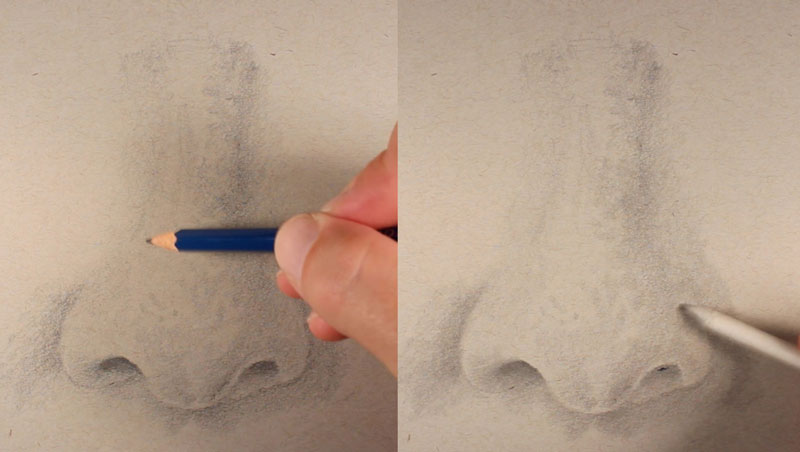
Once the locations of darker value are established with a low-cal awarding, we can define the highlights with a white charcoal pencil. Once more, this application is gently blended with a blending stump.
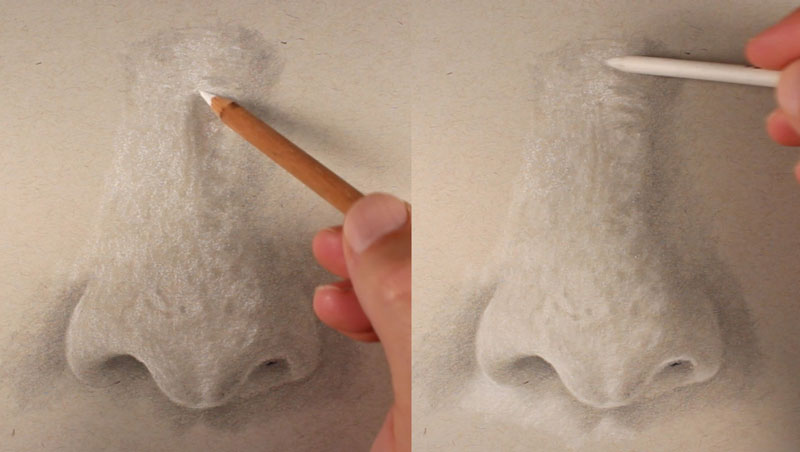
Then it'southward a matter of gradually darkening the shades to increase contrast. A softer and darker, graphite pencil is used the darken the areas inside the nostrils and the shadows that exist on the right side and underneath the olfactory organ.
We can besides go on to add together highlights, if necessary, to extend the range of value and the contrast. Equally applications are fabricated, they are gently composite with a blending stump. You lot'll notice that as the value is developed the texture of the nose is also developed.
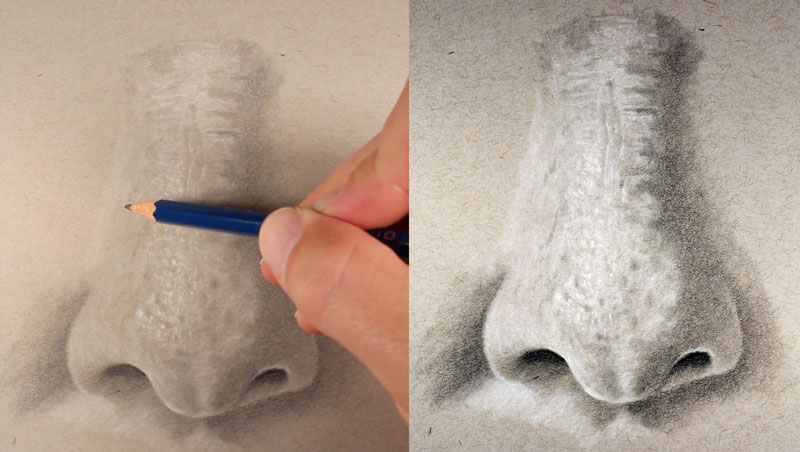
A more in-depth video of this lesson, along with an illustrated ebook can exist constitute in the form, "Portrait Cartoon the Smart Mode".
How to Draw a Olfactory organ Step by Step
Hither's the process that we outlined higher up, simplified and cleaved downwardly into a stride by step arroyo...
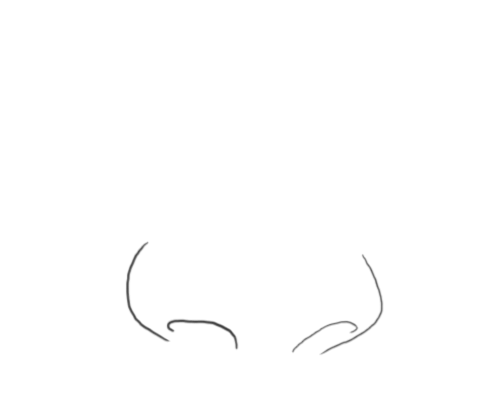
Begin your drawing of a olfactory organ by drawing four lines. Ii lines are drawn for each nostril and so 2 more than for each edge of the nose.
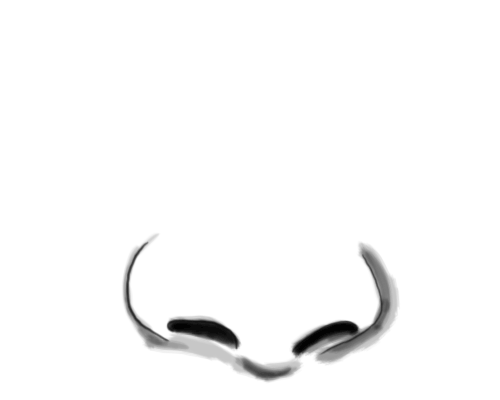
Now you can begin to add darker values where the nose is shaded. Start with the areas that are the darkest and slowly get darker with your pencil.
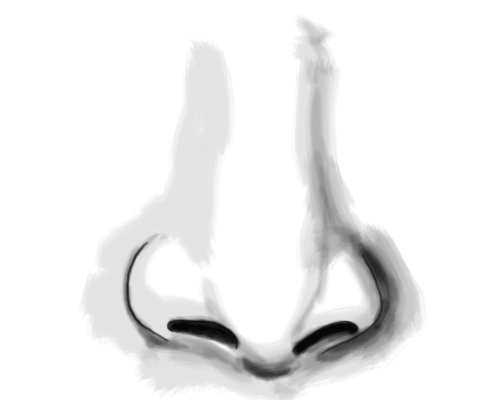
Proceed with adding shading to the nose to create the illusion of a light source. Be careful not add more than lines. Instead, just concentrate on light and dark areas.
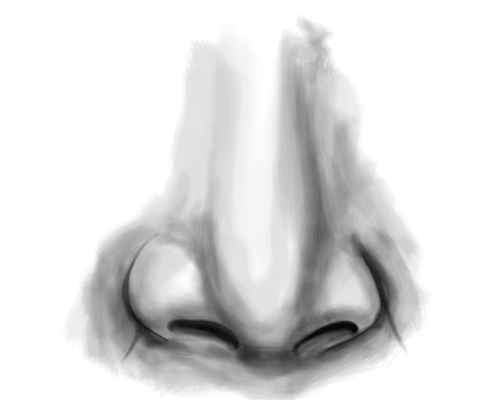
The more value that you add, the more your nose will look realistic. Areas of the nose that are light volition look like they beetle, while areas that are dark will await like they go back in space.
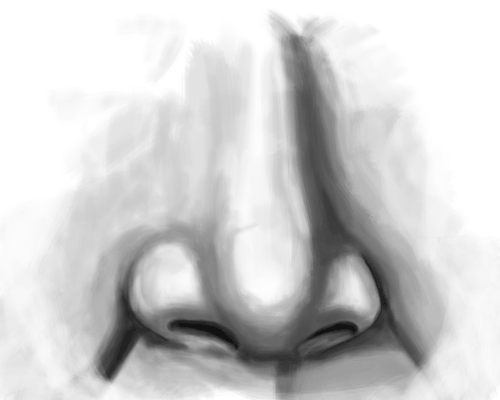
As long as yous keep looking for the nighttime and lite areas on the nose, and draw what you run into, your nose will look realistic.
Once yous have a basic thought of how to draw a nose from a frontal view, it'southward fourth dimension to look at drawing a nose from the side.
Drawing a Nose from the Side View (Profile)
There's more than one manner to describe a nose. In fact, since every olfactory organ is different, there are virtually unlimited means to draw a nose. Side by side, we'll take a look at drawing a nose from a side view. This is usually referred to as a profile view.
As we did with the frontal view, nosotros'll outset locate basic shapes. When drawing a nose from this bending, it may exist difficult to identify the planes, so bones shapes will suffice.
Look for changes in spacial direction to detect the most basic shapes. Equally we see beneath, the upper portion of the nose tin can be simplified with 2 shapes. The lower portion of the nose is simplified into an organic shape that extends downwards from the summit two shapes.
We'll describe these basic shapes showtime to define the grade of the olfactory organ.
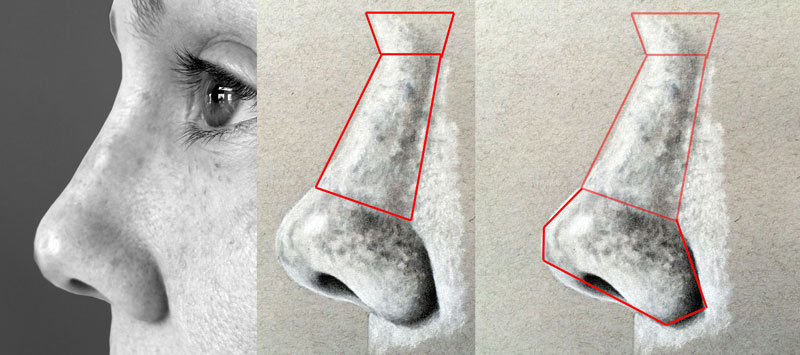
Next, we tin describe the perceived lines that we discussed before along with the outer contours. After these lines are in place, we tin begin the process of developing the value and texture.
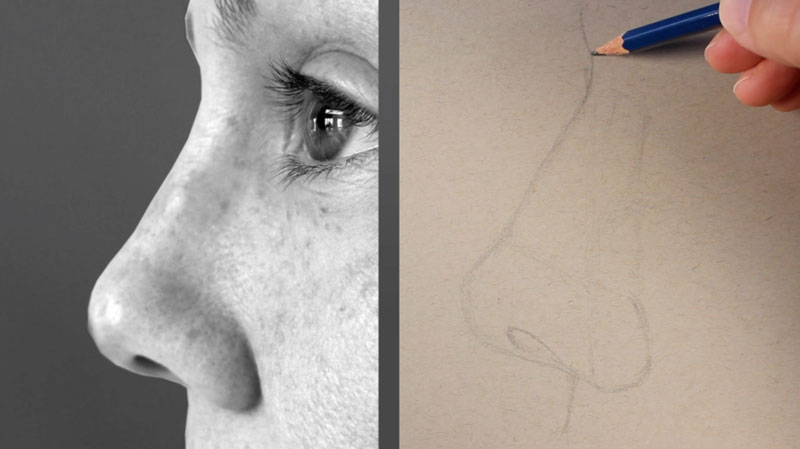
Every bit we develop the value range, nosotros'll consider the lite source. Equally we encounter in this case, the calorie-free source originates from the left. This creates shapes of unlike tones on the olfactory organ. The bridge of the nose receives the most light. The cheeks are too receiving a fair corporeality of calorie-free. Curiously, the bottom of one of the nostrils is likewise lighter. This is the event of light reflecting back up from beneath, producing an area of reflected highlight.
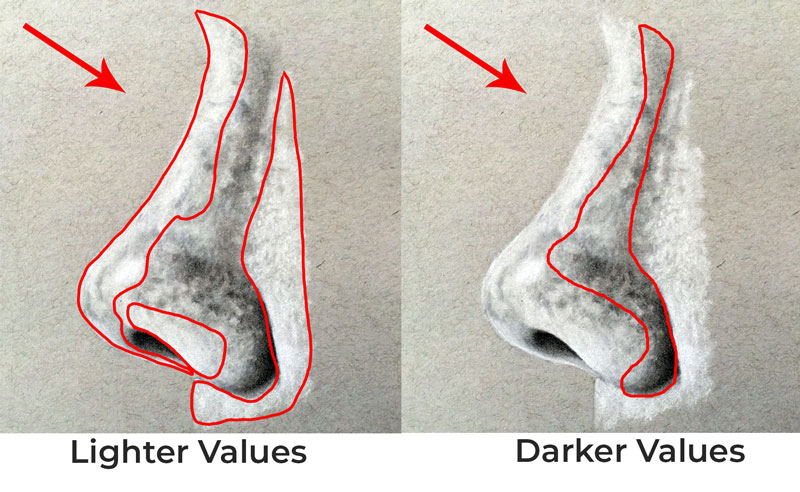
As we did before, we'll start adding light graphite applications to institute the shapes of the darkest value. These applications are blended with a blending stump to create a smoothen texture.

Then we can add the highlights. In this example, we're again working on a toned drawing surface. This allows united states of america to add the highlights with a white medium like white charcoal. After the initial highlights are added, nosotros can blend them as well.
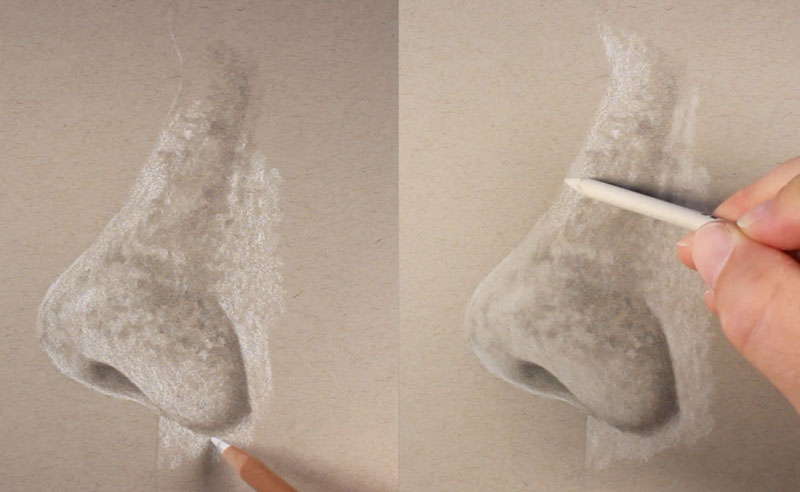
Now nosotros simply need to darken the value to create a total range and increase the dissimilarity in the cartoon. Softer graphite pencils are practical and blended to gradually "push" the tonal range.
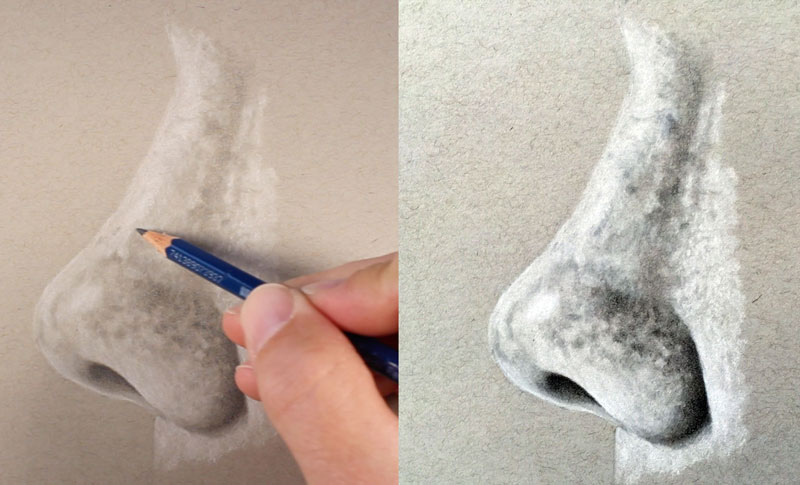
For more on this sit-in see the course, "Portrait Drawing the Smart Way".
Drawing a Olfactory organ From Observation - Put It Into Practise
Now that you've got the basic concept downward, it's fourth dimension to have your skills to an actual subject. This might exist a nose that you draw from life, or ane that y'all draw from a photo reference. Either way, the process of drawing will heavily depend on observation.
When yous are observing a nose, look for the "planes" - or simple geometric shapes that represent how the olfactory organ exists in space.
Take the following drawing for example...
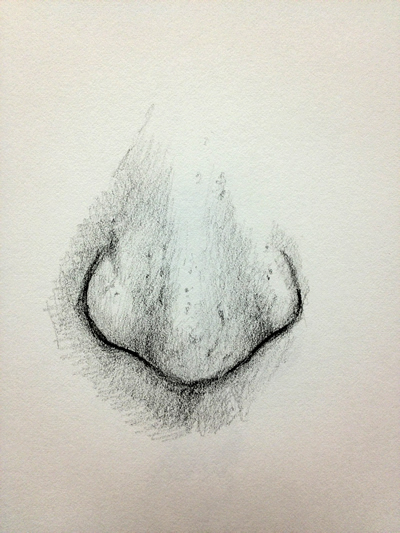
Now look at the planes that can be easily drawn to create the form of the nose...
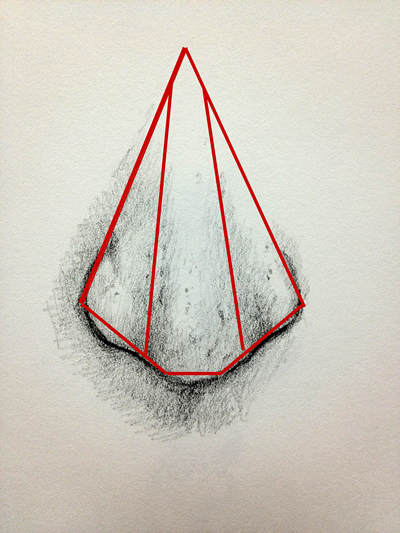
Here's another look at the nose from the side view.
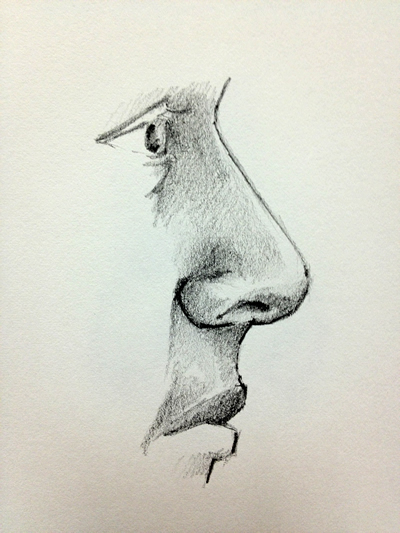
Here is the same drawing with the planes highlighted...
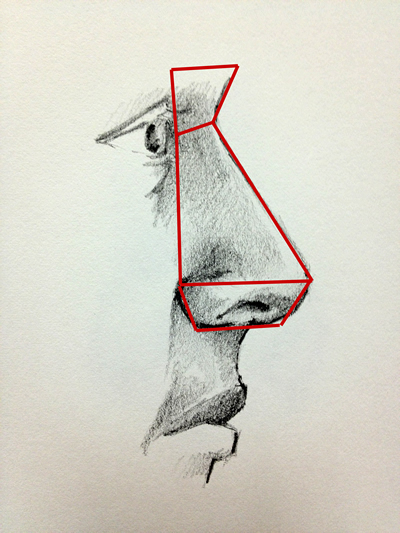
Sure angles of the nose tin present challenges...
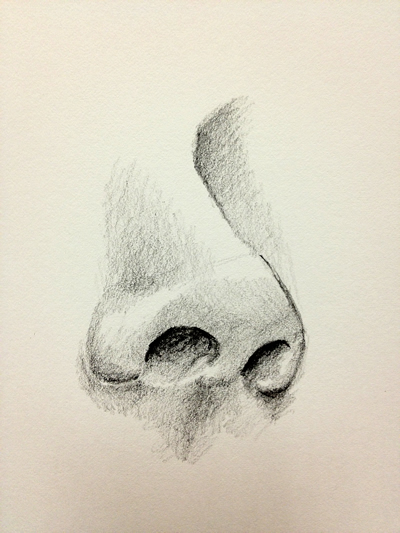
But here again, if you break the nose downward into geometric planes, this angle is fabricated easier to draw...
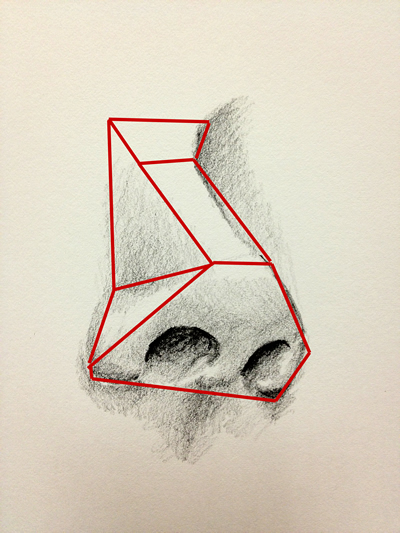
Decision
At present that we've had at look at several unlike noses, you are well equipped to draw your own. Just call back the steps nosotros took...
- Find and draw the planes.
- Draw the perceived lines of the nostrils and contours.
- Develop a range of value and texture.
As always, take your time and be patient. With exercise, y'all'll master the art of drawing noses.
Source: https://thevirtualinstructor.com/graphitenose.html
Posted by: westfalltherwer.blogspot.com


0 Response to "How To Draw A Nose Properlyu"
Post a Comment